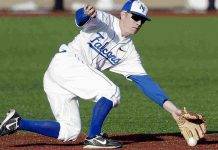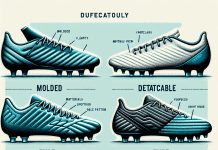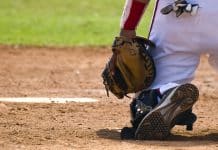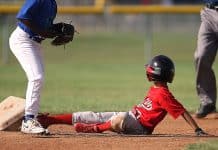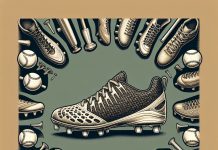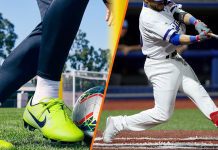Baseball enthusiasts often contemplate the age-old question: what sets metal baseball cleats apart from their molded counterparts?
The choice between these two types of cleats can be pivotal for players, impacting their performance on the field. At the same time, both options provide traction; their distinct advantages and disadvantages present players with contrasting benefits.
In this article, we will explore the disparities between metal and molded baseball cleats, helping you make an informed decision when it comes to stepping up to bat.
Durability
Review contents
Metal cleats
Metal cleats are known for their exceptional durability. They are made from high-quality materials such as steel or hard plastic, ensuring they can withstand the wear and tear of the game. The metal spikes on these cleats provide excellent traction on both grass and dirt surfaces, making them a popular choice among baseball players who play on a variety of fields. With proper care, metal cleats can last for several seasons, making them a worthwhile investment for serious players.
Molded cleats
Molded cleats are made from a durable rubber or hard plastic material. While they may not be as durable as metal cleats, they still offer decent durability. Molded cleats have molded rubber or plastic studs, which provide good traction on most playing surfaces. They are designed to withstand the rigors of baseball, but they may not last as long as metal cleats. However, the durability of molded cleats can vary depending on the brand and quality of the materials used.
Traction
Metal cleats
Metal cleats are widely regarded as the go-to choice for players seeking maximum traction. The metal spikes on these cleats dig into the ground, providing excellent grip and stability. This is particularly beneficial when playing on wet or slippery surfaces. The metal spikes also allow players to dig in and push off with more power, enabling faster acceleration and improved overall performance. However, on artificial turf or some well-groomed fields, metal cleats may not be allowed due to the potential for damage to the playing surface.
Molded cleats
Molded cleats offer good traction on most playing surfaces, but they may not provide the same level of grip as metal cleats. These cleats have molded studs designed for traction on grass and dirt surfaces. While they may not be as effective as metal cleats in terms of digging into the ground, molded cleats are still sufficient for most recreational and amateur players. They balance traction and versatility, making them popular for players who frequently switch between different playing surfaces.
This image is the property of honestbaseball.com.
Playing Surface
Metal cleats
Metal cleats are versatile and can be worn on various playing surfaces. They are particularly effective on natural grass and dirt fields, where the metal spikes can dig in and provide excellent traction.
However, metal cleats may not be suitable for artificial turf or well-maintained fields, as they have a higher likelihood of causing damage to the playing surface. It’s vital to check the rules and regulations of the league or facility you’re playing in to ensure that metal cleats are allowed on the specific playing surface.
Molded cleats
Molded cleats are suitable for a wide range of playing surfaces. They perform well on both natural grass and artificial turf, making them a versatile option for players who play on different types of fields.
Molded cleats have studs that offer good traction on most surfaces without damaging the playing field. This makes them a preferred choice for players at all levels, from youth baseball to professional leagues.
Comfort
Metal cleats
Metal cleats are often praised for their comfort, especially compared to molded cleat models. They are usually designed with padded collars and insoles, providing cushioning and support for the feet.
Metal cleats also tend to have a sturdier construction, offering better ankle stability during lateral movements. However, some players may find the metal spikes uncomfortable, and there may be an initial break-in period required to adapt to the feel of the cleats.
Molded cleats
Molded cleats, especially those made with modern technology, are designed to prioritize comfort. They often feature cushioned insoles, padded collars, and lightweight materials to enhance comfort.
Molded cleats generally provide a snug fit and require minimal break-in time, ensuring players can put them on and get right into the game without discomfort. The absence of metal spikes also eliminates any potential discomfort caused by the protruding spikes.
This image is the property of honestbaseball.com.
Weight
Metal cleats
Metal cleats are generally heavier compared to molded cleats. The metal spikes and sturdier construction contribute to the weight of metal cleats. While some players may prefer the added weight for stability and power, others may find it cumbersome and inhibiting for quick movements. The metal cleats’ weight can also increase fatigue throughout a long game or multiple games.
Molded cleats
Molded cleats are known for their lightweight design, making them popular among players who prioritize agility and speed. The absence of metal spikes significantly reduces the weight of these cleats, allowing for faster movements on the field. The lightweight nature of molded cleats contributes to improved performance, as players can move more freely and with less strain on their feet and legs.
Safety
Metal cleats
While metal cleats provide excellent traction and durability, they do pose a greater risk of causing injuries to other players. The metal spikes can be sharp and may penetrate or puncture players’ skin in a collision or accidental contact. Due to these safety concerns, some leagues and organizations have banned metal cleats in youth baseball or specific age groups. It is essential to prioritize safety and consider the rules and regulations of the league or facility when deciding on the type of cleats to wear.
Molded cleats
Compared to metal cleats, molded cleats are generally considered safer due to the absence of metal spikes. The molded studs provide traction without the risk of puncturing or cutting the skin during a collision or accidental contact. Molded cleats are often preferred for younger players or leagues prioritizing safety. However, it is still essential to be mindful of the playing conditions and ensure that the molded cleats offer adequate traction and stability to prevent slips and falls.
This image is the property of inningace.com.
Price
Metal cleats
Metal cleats tend to be more expensive than molded cleats. The higher price is often attributed to the higher quality materials used in their construction and the durability and performance they offer. While the initial cost may be higher, metal cleats have the potential to last several seasons with proper care, making them a long-term investment for serious players.
Molded cleats
Molded cleats are generally more affordable compared to metal cleats. They are made with less expensive materials, such as rubber or hard plastic, contributing to their lower price point. Molded cleats are cost-effective for players new to the game or those who do not play as frequently. However, it is essential to choose a reputable brand to ensure quality and durability, as some lower-priced models may not hold up well over time.
Versatility
Metal cleats
Metal cleats offer greater versatility in terms of the playing surfaces they can be worn on. They provide excellent traction on grass and dirt fields, allowing players to perform at their best in various conditions. Metal cleats are commonly used by players who compete at different parks or travel for games, as they can adapt to different surfaces.
However, it is crucial to check the rules and regulations of each facility to ensure that metal cleats are allowed, as they may be prohibited on artificial turf or well-maintained fields.
Molded cleats
Molded cleats are also versatile but to a slightly lesser extent than metal cleats. They are suitable for grass and dirt surfaces, making them adequate for most baseball fields. Many molded cleats also perform well on artificial turf, which is commonly found in indoor or multi-purpose baseball facilities.
Molded cleats are favored by players who play on a variety of fields but may not require the highest level of traction for their specific playing style.
This image is the property of honestbaseball.com.
Maintenance
Metal cleats
Metal cleats require regular maintenance to ensure their longevity and optimal performance. After each use, removing any dirt or debris stuck in the metal spikes is essential to prevent them from becoming dull or damaged. Metal cleats should be dried thoroughly after each game or practice to prevent rusting. Additionally, it is vital to regularly inspect the spikes for wear and tear and replace them if necessary. With proper maintenance, metal cleats can maintain their durability and performance for several seasons.
Molded cleats
Molded cleats are generally low-maintenance compared to metal cleats. After each use, removing any dirt or mud from the studs using a soft brush or cloth is recommended. Molded cleats should also be air dry to prevent unpleasant odor or bacterial growth. While the studs on molded cleats do not need to be replaced like metal spikes, it is still important to periodically check for any signs of wear or damage and replace the cleats if necessary.
Youth Baseball
Metal cleats
In youth baseball, metal cleats can vary depending on the league or organization’s rules and regulations. Some leagues prohibit metal cleats for safety reasons, particularly for younger age groups. The metal spikes on these cleats pose a higher risk of injury in collisions or accidental contact. However, metal cleats may be allowed in older age groups or more competitive leagues. It is essential to check with the league or organization to ensure compliance and prioritize the safety of young players.
Molded cleats
Molded cleats are the preferred choice for youth baseball for their safety and versatility. These cleats provide good traction without the added risk of injury from sharp metal spikes.
Molded cleats are suitable for most playing surfaces, including grass, dirt, and artificial turf, commonly found in youth baseball facilities. They offer the necessary support and comfort for young players, allowing them to focus on the game and enjoy their baseball experience without compromising safety.
In conclusion, the choice between metal cleats and molded cleats ultimately depends on the player’s needs, playing style, and the specific requirements of the league or facility. Metal cleats offer excellent durability, traction, and versatility on a range of playing surfaces but come with higher costs and safety concerns.
On the other hand, molded cleats provide comfort, safety, and versatility at a more affordable price point. Whether you prefer the exceptional performance of metal cleats or the lightweight agility of molded cleats, both options provide valuable tools to enhance your baseball game.
This image is the property of www.forelle.com.
Under Armour Men's Leadoff Low Rubber Molded Baseball Cleat Shoe, Black, 10.5
2 used from $28.15
New Balance Men's Fresh Foam 3000 V6 Molded Baseball Shoe, White/White, 11
New Balance Men's FuelCell 4040 V6 Molded Baseball Shoe, Black/White, 10.5
Under Armour Men's Harper 7 Mid Rubber Molded Baseball Cleat Shoe, (100) White/White/Mod Gray, 7
Under Armour Men's Leadoff Mid Rubber Molded Baseball Cleat Shoe, (400) Royal/White/White, 8.5
$39.95 in stock
adidas Men's Icon 7 TPU Baseball Shoe, White/Silver Metallic/Black, 11
$55.89 in stock
New Balance Men's Fresh Foam 3000 V6 Mid-Molded Baseball Shoe, Black/White, 15
$89.16 in stock

















